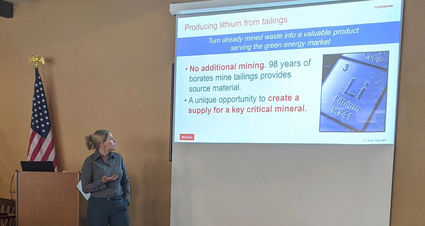Rio Tinto shares its 148-year history
March 14, 2020

Therese Luther
Amanda Smith, new general manager of the Rio Tinto operations in Boron spoke to the Mojave Chamber of Commerce on Feb. 27.
The featured speaker at the Feb. 27 meeting of the Mojave Chamber of Commerce was Amanda Smith, new general manager of the Rio Tinto operations in Boron. Smith came on board very recently after several years abroad at other Rio Tinto facilities, including Australia.
Rio Tinto currently operates in about 35 countries, in mines, smelters and refineries, as well as in sales offices, data centers, research and development labs and with artificial intelligence. Rio Tinto operates in three locations in California – Boron, Wilmington and Owen's Lake. Boron is a mining facility. It is a primary process and refining facility dealing in boric acid, sodium borates and boric oxide.
Rio Tinto has a 148-year history in California, beginning in Death Valley. Ninety three of those years are in Boron.
The borates produced at the Rio Tinto mines were originally household staples, used in medicines, food additives and household cleaners. Smith noted that in 1872 it took the famous 20 mule team one week to haul 20 tons of borax to make one product. In 2020, one haul truck (2,700 mules) takes less than one hour to haul 270 tons of borax to make 16 products.
The Boron mine contains one of the richest borate deposits in the world and supplies approximately 30 percent of the world's borates. The borates produced by the Rio Tinto mines domestically and internationally go into making hundreds of products, among them, caulks, fertilizers, ceramics, cleaners, fire retardancy, glass, insulation, mobile devices and wood protection. The minerals produced are essential for human progress, said Smith.
It is safe to say that all of us in one way or another use products made with borates. As a pioneer in mining and materials, what the company does is important, but even more important is HOW they do it, according to Smith. The company's philosophy is that their employees are their greatest asset. The employees are encouraged to be team players, think big and continue learning.
Recently employees at the Boron open pit mine site have made an extremely important discovery. While searching piles of waste rock looking for valuable minerals, workers discovered high concentrations of lithium. The lithium in the Boron waste rock tests in higher concentration than other deposits being considered for development elsewhere in the United States.
Smith said the mine has the potential to become America's largest domestic producer of battery grade lithium, all without the need for further mining. This potentially turns nearly 100 years of waste material into a valuable product serving the green energy market. Lithium-ion batteries are the key to lightweight, rechargeable power for laptops, phones and other digital devices, including electric cars.
The technicalities of extracting the lithium from the waste rock has been researched and proven, Smith said, and at this point Rio Tinto is looking into the economics. A demonstration plant should be ready to operate in the late spring and it will probably take three to six months to prove the economic viability of extracting the lithium. Lithium production has the potential to extend the life of the Boron mine and associated plant beyond the proposed 2050 date for borate mining operations.
Built in 1997, the Visitor Center at Rio Tinto Boron offers an opportunity to explore U.S. Borax's 150-year history as an American icon. Weather permitting, the Visitor Center is open seven days a week from 9 a.m. to 5 p.m. (last entry is at 4:45 p.m.), excluding major holidays. Admission is free.




